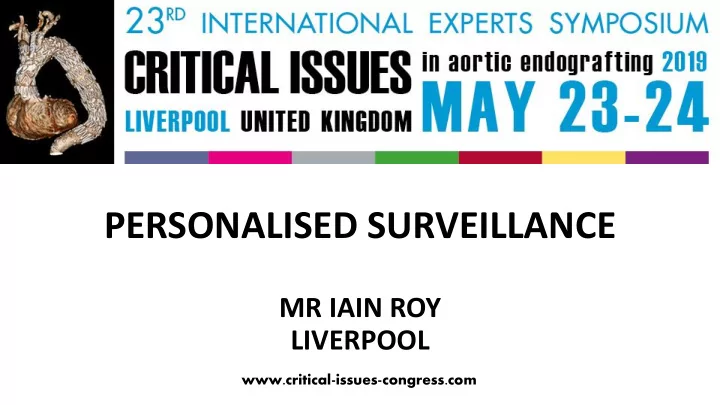

PERSONALISED SURVEILLANCE MR IAIN ROY LIVERPOOL www.critical-issues-congress.com
Disclosure Speaker name: Iain N Roy I have the following potential conflicts of interest to report: Consulting Employment in industry Shareholder in a healthcare company Owner of a healthcare company Other(s) : Almost certainly influenced by the support & training industry have provided for me.
Need for Surveillance vs
The problem(s) Look at the proposed solutions Personalisation
The Problem(s)
Surveillance = Screening W.H.O screening criteria 1. The condition sought should be an important health problem. 2. There should be an accepted treatment for patients with recognised disease. 3. Facilities for diagnosis and treatment should be available. 4. There should be a recognisable latent or early symptomatic stage. 5. There should be a suitable test or examination. 6. The test should be acceptable to the population. 7. The natural history of the condition, including development from latent to declared disease, should be adequately understood. 8. There should be an agreed policy on whom to treat as patients. 9. The cost of case-finding (including diagnosis and treatment of patients diagnosed) should be economically balanced in relation to possible expenditure on medical care as a whole. 10.Case-finding should be a continuing process and not a 'once and for all' project.
https://doi.org/10.1016/j.ejvs.2018.10.032
1 0,9 0,8 0,7 0,6 0,5 0,4 Inefficient ≠ Ineffective 0,3 0,2 0,1 0 0 1 2 3 4 5 6 7 8
Surveillance Is Inefficient inefficient failure to make the best use of time or resources Blanket surveillance regimen for all patients despite huge variations in risk between patients and over time. Clinicians Patient compliance is variable but generally poor
Look at the proposed solutions
SGVI (0·03675 × maximum sac diameter) + (0·05009 × largest common iliac diameter) > 3·76571 High Risk BJS, Volume: 100, Issue: 10, Pages: 1302-1311, First published: 25 June 2013, DOI: (10.1002/bjs.9177)
“Swe - dam” VI All sealing zones at least 10 mm and no endoleak on first post-op CTA BJS, Volume: 105, Issue: 6, Pages: 709-718, First published: 26 March 2018, DOI: (10.1002/bjs.10766)
Personalisation
Personalised Surveillance personalise design or produce something to meet someone's individual requirements personalised medicine the process by which people with long-term illnesses or conditions receive support / treatment that is tailored to their individual needs and wishes Group stratification of risk - improves overall efficiency but does not take into account individual wishes Intuitively it is unlikely to have an effect on compliance
Personalised Surveillance To personalise surveillance: 1. Need to predict future individual risk at different points in surveillance (not just at operation) 2. Find a way to accurately convey that risk to the patients 3. Adopt a personalised approach to surveillance with patients involved in their decisions
Personalised Surveillance All infra-renal EVAR surveillance visits in our institution between 2008- 2015 reviewed. Complete data on 3,160 Visits In 797 individual patients (Mean= 3.9 visits/patient) Male: 2766 Female: 394
Poisson Model Creation Manually extracted variables from Colour Duplex & Plain Film x-ray reports CDU Diagnostic Scan (True/False) Endoleak Flow direction (Free Text)* Non-diagnostic (Factor) Limb Issue (True/False) Max AAA Size (mm) Effected Limb (Left / Right)* Max Iliac Size (mm) Limb (Occlusion/Stenosis/Normal)* Limb Min PSV (m/s)* Heterogenous ‘sac’ Thrombus (True/False) Limb Max PSV (m/s)* Endoleak Present (True/False) Thrombus in Lumen (True/False) Endoleak Type Ia/Ib/II/III/Unknown (True/False) AXR Abnormality(True/False) Proximal Dilation (True/False) Migration (True/False) Structural Failure (Factor) Migration (Factor) Limb Kink (True/False) Patient age (at operation) – Pre-op Diameter – Time since operation – Previous Secondary Intervention
AUC = 0.72
Conclusions • It is possible to accurately predict individual risk of requiring secondary intervention over time • Reproducible on each surveillance visit • Need to reconsider the methodology and system we use to perform surveillance with much more patient involvement • Interval to next surveillance visit based on patients tolerance of risk This could render each visit equally likely to trigger a Secondary intervention.
Recommend
More recommend